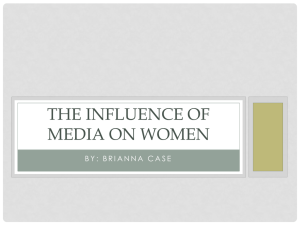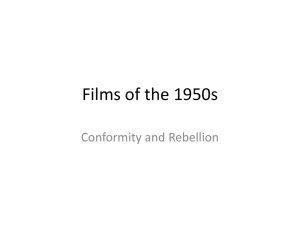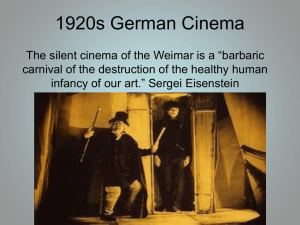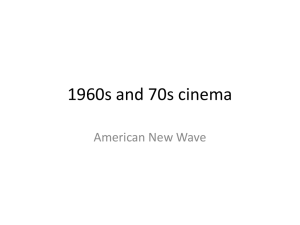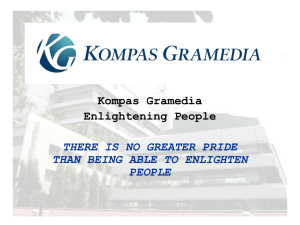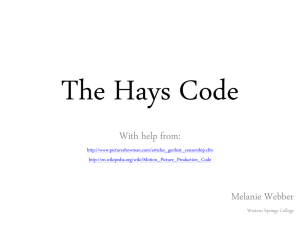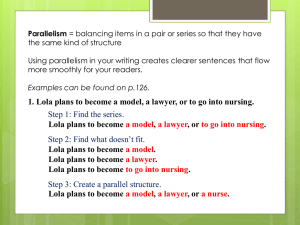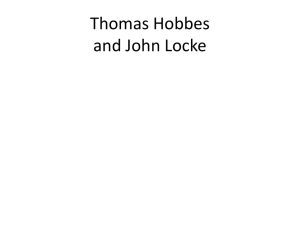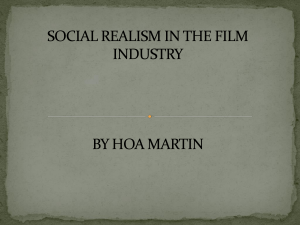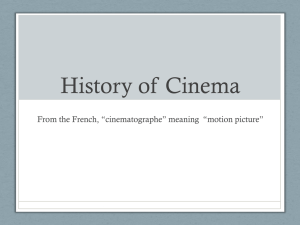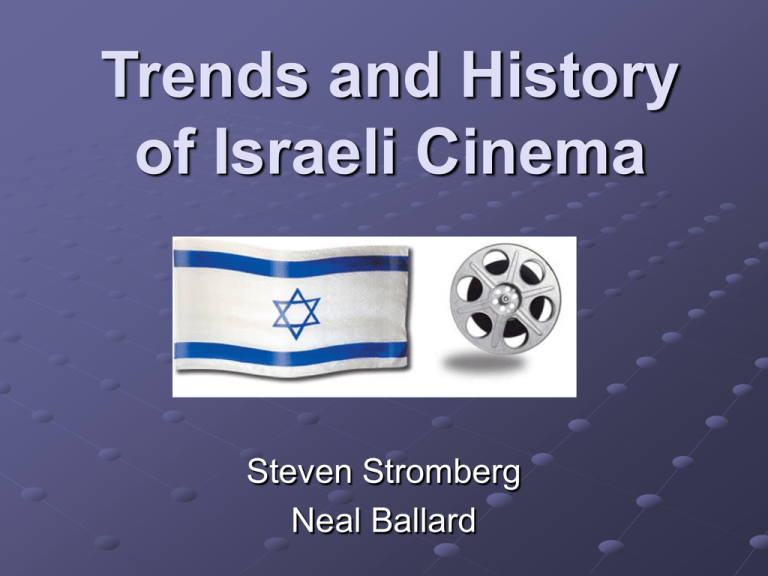
Trends and History
of Israeli Cinema
Steven Stromberg
Neal Ballard
The Yishuv Period (Pre-Statehood)
Late 19th Century – 1948
Edison and the Lumiere brothers (as well as other
outside filmmakers) came to Palestine to shoot “exotic”
footage.
Films were imported from Europe and America
The beginnings of the Israeli film industry: travelogues,
documentaries and eventually narrative films.
Most productions were influenced and supported by
Zionist movement.
Archetypal character of the Sabra (native-born Israeli) is
introduced.
Films contributed to renewal of Hebrew as a secular
language.
Important Filmmakers and Films of
the Yishuv period.
Nathan Axelrod (1905 – 1987)
Oded the Wanderer (1933)
Over the Ruins (1938)
Baruch Agadati (1895 – 1976)
This Is the Land (1935)
AGA Film Co.
Oded the Wanderer
Important Films
Oded the Wanderer (1933)
Sabra (d. Aleksander Ford) (1933)
Sabra
Post 1948: Heroic-Nationalist Genre
Practically no narrative films were made between 1933 and the creation of
the State of Israel
Films reflected issues in Israeli society:
Large numbers of new immigrants
Zionism
Heroes of the War of Independence
Memories of the Holocaust
Six Day War
Serious limitations on production
Films produced primarily for audiences abroad
Focused primarily on the Arab / Israeli conflict
Arab roles were either very stereotypically anonymous or
negatively portrayed
Post 1967 War:
Americanization of Israeli culture and films
More epic films / larger budgets reflecting post war economic
prosperity
Important Filmmakers and Films of
Heroic – Nationalist genre
Many producers and directors were recent immigrants to Israel.
Larry Frisch
Tel Aviv Taxi (1954)
Pillar of Fire (1959)
Thorold Dickinson
The Red Background (1953)
Hill 24 Doesn’t Answer (1955)
Pillar of Fire
Nuri Habib
Without a Homeland (1952)
(First color film in Israel)
Rachel (1958)
Important Films
Rebels Against the Light (1964)
Hill 24 Doesn’t Answer (1955)
Hill 24 Doesn’t Answer
“Bourekas” / Escapism
Mostly 70s and 80s
Deals with ethnic stereotypes (interplay between
Ashkenazi and Sephardi Jews)
Filmmakers wanted to address the needs of the
Sephardi Jews because they were becoming the
majority
Low budget ethnic comedies, heavily emotional
melodramas, ethnic nostalgia, teen sex comedies, and
light entertainment
Retreat from old Zionist values
Severe criticism because of little cinematic or artistic
sophistication
Important filmmakers and films of
“Bourekas” / Escapist Cinema
George Ovadiah
Harbour of Love (1967)
Arianna (1971)
Ze’ev Revach
Only Today (1976)
Batito (1987)
Sallah
Important Films
Sallah (1964)
Light Out of Nowhere (1973)
(d. Ephraim Kishom)
(d. Nissim Dayan)
House on Chelouche Street (1973)
(d. Mose Mizrachi)
Light Out of Nowhere
Personal & Allegorical Cinema
Counter-response to “Boureka/Escapist” and National-Heroic Genres of film
Younger generation of Israeli filmmakers (1960s – 1970s)
“Kayitz” movement
Influenced by French New Wave; many studied in Paris
Individual Issues:
Disillusionment / “ideology-of-having-no-ideology”
Marginality of the protagonist.
Criticism of Society
Issues in Israeli Society:
Individual vs. National Identity; the personal/political and the
private/historical are linked together.
What defines the state of Israel (shifting borders)? / Who is a Jew
(many diasporas)?
Post-Holocaust Jewish survival
Individual characters can be representative of the state.
Important Filmmakers and Films in
Personal & Allegorical Cinema
Uri Zohar
Hole in the Moon (1965)
Three Days and a Child (1967)
Dan Wolman (1941- )
Hole in the Moon
The Dreamer (1970)
My Michael (1975)
My Michael
Return of the Repressed:
The Palestinian Wave
Student films began focusing on Israeli/Arab
conflict in new ways.
Films began to include Palestinian characters
(mostly in minor roles).
Films operate w/in a general framework and
assumption of Zionism and Arab/Israeli conflict
as a given.
Wider social and cultural perspectives;
dependant on equality between “Oriental” Jews,
European Jews and Palestinian Arabs
Important Films and Filmmakers in
the Palestinian Wave of Cinema
Uri Barabash
Beyond the Walls (1985)
Nissim Dayan
A Very Narrow Bridge (1985)
Beyond the Walls
Shimon Dotan
The Smile of the Lamb (1986)
Avanti-Popolo (1986)
A Very Narrow Bridge
Observations
Israeli Film History and Genres somewhat parallel
American/Hollywood Films
National-Heroic = John Wayne, John Ford
Bourekas/Escapist = Howard Hawkes, Billy Wilder
Personal/Allegorical = Martin Scorsese, Francis Ford Copolla, etc.

